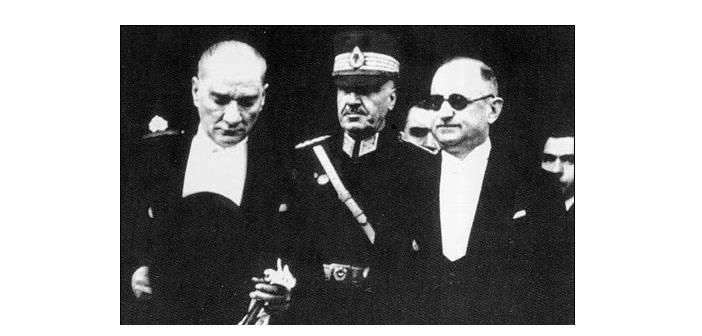Soykırım’ın valisi, Cumhuriyet’in bakanı: Abdülhalik Renda


İttihat ve Terakki rejimi ile tek parti rejimi arasındaki devamlılık unsurları son yılların en çok konuşulan tarihsel olgularından biri. Kadro ve ideoloji noktalarında göze çarpan bu devamlılık unsurları, kurulan yeni rejimin niteliğini ve toplumsal mühendislik girişimlerini anlamak açısından oldukça önemli. Mustafa Abdülhalik Renda gibi Ermeni Soykırımı’nın yürütülmesinde bilfiil rol almış İttihatçılara Cumhuriyet döneminde muhacirlerin iskânı ve Kürt meselesi gibi konularda önemli görevler verilmesi İttihat ve Terakki’nin toplumsal mühendislik yaklaşımının Cumhuriyet döneminde devletin şiddet, göçe zorlama ve asimilasyon pratiklerinin şekillendirilmesinde etkili olduğunu açıkça göstermekte.

Talat Paşa’nın kayınbiraderi
1881’de Yanya’da doğan, Talat Paşa’nın kayınbiraderi Abdülhalik Bey, Mülkiye’den mezun olduktan sonra çeşitli memuriyet ve kaymakamlık görevlerinde bulunur. Balkan Savaşları’nın ardından önce Siirt mutasarrıflığına, daha sonra 26 Mart 1914’te Bitlis valiliğine tayin edilir. Buraya atanmasının nedeni, İttihatçı hükümete ve Doğu vilayetlerinde ıslahat öngören Osmanlı-Rusya Anlaşması’na karşı kalkışılan Şeyh Selim önderliğindeki isyandır. İsyanı bastırmakta aciz kaldığı öne sürülen Bitlis Valisi Mazhar Bey görevden alınır, yerine Abdülhalik tayin edilir. İsyanın bastırılmasında önemli role sahip olan Abdülhalik Bey, merkeze Van Valisi Tahsin Bey ile ortak bir telgraf göndererek, Kürdistan ahvalinin ıslahat için uygun olmadığını, şeyhlerin, mollaların ve Abdürrezzak Bedirxan’ın halkı isyana sevk ettiklerini belirtir ve sert tedbirler alınmasını ister. Bunun üzerine, hükümet karşıtı Kürt aşiretleri ve şeyhlere karşı ‘ehlileştirme’ çalışmaları başlar ve devlet, bazı aşiret reisleri ve eşrafla işbirliği içinde bölgede etkisini artırmaya çalışır.
Bitlis’te katliamlar
Soykırımın Bitlis’te yürütülmesinde Abdülhalik’in başat bir rolü bulunmaktadır. Nisan 1915’in sonlarında, Dr. Nazım ile Abdülhalik’in Ermenilerin kırımına dair bir görüşme gerçekleştirdiğine dair bilgiler mevcuttur. Zaten İstanbul’daki Ermeni aydınlarının tutuklanmasına paralel olarak Ermeni ileri gelenlerine yönelik tutuklamalar Bitlis’te de başlar. Abdülhalik, bölgede Kürtler ve diğer gruplar arasından çeteler oluşturur, Haziran’ın ortasından itibaren tutuklamalarla birlikte Bitlis’in çevre bölgelerinde katliamları organize eder. Van’dan çekilen Cevdet Bey’in kasap taburları ve Yarbay Halil Bey komutasındaki birliklerle birlikte Bitlis, Siirt, Muş, Hizan ve Genç bölgelerini Ermenilerden temizler. Bu dönemin tanıkları, Muş’ta Ermeni yerleşimlerinin bombalanarak yakıldığını, Ermenilerin çoğunun evlerinde yanarak öldüğünü, şehrin yıkıntı halinde olduğunu not düşerler.
Abdülhalik, Bitlis’in ardından, Eylül 1915’te Halep valiliğine tayin edilir. Eski Halep Valisi Bekir Sami’nin Ermenilerin tasfiyesini gerçekleştirmekteki acizliği, Abdülhalik’in bu göreve atanmasındaki nedenlerin başında gelmektedir. Yeni görevi, Batı’dan sürülüp Suriye’ye ulaşmış olan Ermenilerdir. Burada, kamplardan Halep şehrine kaçmaya çalışan Ermenilerin şehre girişini engellemekten, şehirde saklanan Ermenilerin yeniden kamplara sürülmesine kadar birçok görevi yerine getirir.
Yargılanmadan serbest
Savaş bittikten ve İttihatçı hükümet düştükten sonra, işlediği suçlardan dolayı tutuklanarak Bekir Ağa Bölüğü’ne konulur. Burada bir süre tutuklu kaldıktan sonra serbest kalır, ancak Mayıs 1920’de İngilizler tarafından tutuklanarak Malta’ya gönderilir. Abdülhalik, Ermeni katliamlarında yönetici konumunda olanlar kategorisine konarak yargılanacaktı. Ona yöneltilen suçlamalar arasında, Ermenilerin sürülmesi ve toplu olarak katledilmesi için yapılan toplantılara katılmak, Bitlis, Muş ve Sason bölgelerindeki Ermenileri katletmek ve Ermeni mallarına el koymak vardır. Malta belgelerine göre, Bitlis’te 150 bin Ermeni’nin öldürülmesinin sorumluları arasındadır.
Bütün bu suçlamalara rağmen, Abdülhalik Bey, Ankara hükümeti ile İngiltere arasında imzalanan esir değişimi anlaşmasıyla yargılanmadan serbest kalır. Malta’dan döner dönmez, müsteşarlık ve valilik görevlerinde bulunan Abdülhalik, İzmir’in yakılmasının ardından, kentin Kemalist güçlerce ele geçirilmesinden sonra buraya atanan ilk vali olur. Kendisi aynı zamanda Mustafa Kemal’e en yakın isimlerden biridir. Öyle ki, Latife Hanım ile evlendiklerinde nikah şahitlerinden biri de Abdülhalik’tir. 1923 seçimlerinden sonra Çankırı milletvekili olur. Daha sonra Maliye Vekili olarak göreve başlar.
Türkleştirme görevi
Şeyh Said İsyanı patlak verdiğinde Abdülhalik tekrar devreye girer. Bölgeyi bilmesinden dolayı incelemelerde bulunmak üzere Kürt illerine gönderilen komisyonun başkanı olur. Gezi sırasında İsmet İnönü’ye telgraf çeken Abdülhalik, Kürt meselesinin en iyi şekilde hal olması için Ermenilerden boşaltılan yerlere Türk muhacirlerin yerleştirilmesi gerektiğini söyler. Diyarbekir, Siirt, Bitlis, Van ve Muş’ta Ermeni mallarının satılmaması, iskan için tutulmasını önerir. Bu önerilerini, rapor halinde İnönü’ye sunar. 25 Eylül 1925’te kabul edilen Şark Islahat Planı, Abdülhalik’in raporu temel alınarak hazırlanır. Kısacası, Ermenilerin bölgeden atılmasında kilit role sahip olan Abdülhalik, bu sefer, bölgenin Türkleştirilmesi görevini üstlenir. Bu kapsamda, muhacirlerin bölgeye yerleştirilmesi, ‘isyan’ potansiyeline sahip aşiretlerin iç bölgelere sürülmesi, Kürtçe’nin yasaklanması gibi pratiklerin uygulanmasında önemli katkılar sağlar. Maliye, Milli Savunma, Bahriye bakanlığı görevlerinde bulunan Abdülhalik Bey, 1935’te TBMM Başkanı seçilir ve 1946 yılına kadar bu görevi sürdürür.
Binlerce Ermeni’nin sürülmesinde ve katledilmesinde rolü olan Abdülhalik Bey, yargılanmak bir yana, yeni rejimde kilit görevler üstlenerek meclis başkanlığına kadar yükselmiştir. Soykırımın çeşitli safhalarında uygulamasına katkı sağladığı nüfus mühendisliği, şiddet ve asimilasyon pratiklerine dair bilgileri ve yaklaşımı tek parti rejiminin Kürt meselesine ve muhacirlerin iskânına yönelik geliştirdiği stratejilere de ışık tutmuş, Abdülhalik Bey bu konularda devlet politikasının belirlenmesinde etkili bir rol üstlenmiştir.


